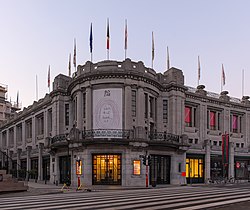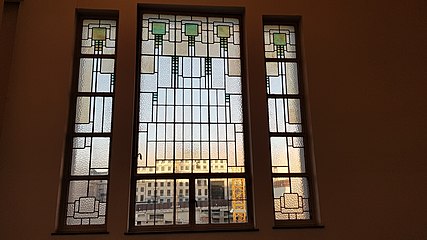
Victor Pierre Horta was a Belgian architect and designer, and one of the founders of the Art Nouveau movement. He was a fervent admirer of the French architectural theorist Eugène Viollet-le-Duc and his Hôtel Tassel in Brussels (1892–93), often considered the first Art Nouveau house, is based on the work of Viollet-le-Duc. The curving stylized vegetal forms that Horta used in turn influenced many others, including the French architect Hector Guimard, who used it in the first Art Nouveau apartment building he designed in Paris and in the entrances he designed for the Paris Metro. He is also considered a precursor of modern architecture for his open floor plans and his innovative use of iron, steel and glass.
Paul Saintenoy was a Belgian architect, teacher, architectural historian, and writer.
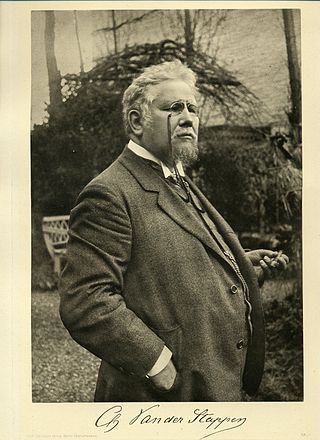
Charles van der Stappen, was a Belgian sculptor, born in Saint-Josse-ten-Noode.

The Royal Museums of Fine Arts of Belgium are a group of art museums in Brussels, Belgium. They include six museums: the Oldmasters Museum, the Magritte Museum, the Fin-de-Siècle Museum, the Modern Museum, the Antoine Wiertz Museum and the Constantin Meunier Museum.
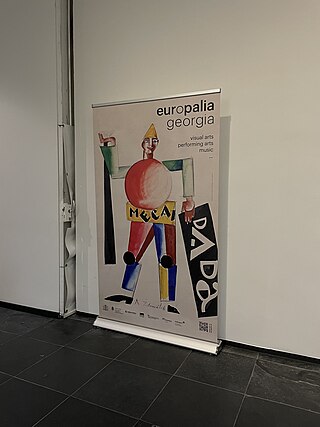
Europalia is a Brussels-based, international biennial arts festival that highlights the cultural heritage and art scene of one invited country. On multiple occasions, the festival has also dedicated editions to a theme rather than a country. Europalia was established with the aim of bringing the arts and culture of European countries to the heart of Europe itself. Although, since 1989 – with Europalia Japan – non-european countries have also featured. The very first festival in 1969 was dedicated to Italy.

The Academy Palace or Palace of the Academies is a neoclassical palace in Brussels, Belgium. It was originally built between 1823 and 1828 for Prince William II of Orange. Nowadays, it houses five Belgian academies including the Royal Academies for Science and the Arts of Belgium (RASAB). In English, it is also often called the Academy House.

The Musée des Beaux-Arts in Tournai, Belgium, is an art museum.

The Hôtel van Eetvelde is a historic town house in Brussels, Belgium. It was designed by Victor Horta for Edmond van Eetvelde, administrator of Congo Free State, and built between 1895 and 1898, in Art Nouveau style. It is located at 4, avenue Palmerston/Palmerstonlaan in the Squares Quarter. Two extensions, also designed by Horta, were added between 1898 and 1901.

The Pavilion of Human Passions, also known as the Horta-Lambeaux Pavilion, is a neoclassical pavilion in the form of a Greek temple that was built by Victor Horta in 1896 in the Parc du Cinquantenaire/Jubelpark of Brussels, Belgium. Although classical in appearance, the building shows the first steps of the young Victor Horta towards Art Nouveau. It was designed to serve as a permanent showcase for a large marble relief The Human Passions by Jef Lambeaux.

The Royal Academy of Fine Arts of Brussels is an art school established in Brussels, Belgium. It was founded in 1711. Starting from modest beginnings in a single room in Brussels' Town Hall, it has since 1876 been operating from a former convent and orphanage in the Rue du Midi/Zuidstraat, which was converted by the architect Victor Jamaer. The school has played an important role in training leading local artists.

The Brussels International Exposition of 1935 was a world's fair held between 27 April and 6 November 1935 on the Heysel/Heizel Plateau in Brussels, Belgium.

Gabriel Van Dievoet was a Belgian decorator and Liberty style sgraffitist. He was the brother of the architect Henri Van Dievoet.

The major town houses of Victor Horta are four town houses in Brussels, Belgium, which have been listed as a UNESCO World Heritage Site since 2000. All four houses were designed and built by the Belgian architect Victor Horta (1861–1947), who pioneered the Art Nouveau style during the mid-1890s.

The Brussels International Exposition of 1897 was a world's fair held in Brussels, Belgium, from 10 May 1897 through 8 November 1897. There were 27 participating countries, and an estimated attendance of 7.8 million people.
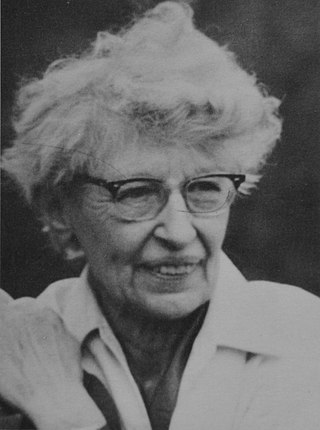
Éliane Georgette Diane de Meuse was a Belgian painter. She was the wife of Max Van Dyck. They met at the Académie Royale des Beaux-Arts, Brussels where they attended the courses of the same professors.
Michel Draguet is a Belgian art historian, professor at the Université libre de Bruxelles, and the director and CEO of the Royal Museums of Fine Arts of Belgium since May 2005. Draguet is a member of the board of the federal administration for science: the Belgian Science Policy Office (BELSPO).
Henry Le Bœuf was a Belgian banker, patron of the arts and music lover.
Marie-Françoise Plissart is a Belgian photographer and video artist.
Charles Leirens was a Belgian photographer and musician. He started giving concerts in public at the age of eight and after studying composition in college composed music for a time. During World War I he worked for the Belgian services in London. In 1928 he became the first Director-General of the Palais des Beaux-Arts, Brussels, creating La Maison d’Art in December 1933; cofounded the Revue Internationale de Musique (1936–1952). He also made photographic portraits of celebrated artists from the 1930s to the 1960s. He spent most of World War II in the United States, teaching, writing and exhibiting his work. After the war, he traveled as a photographer to Puerto Rico and Morocco, before returning to Belgium, remarrying and continuing to perform concerts and exhibit photographic work.

The Art Deco movement of architecture and design appeared in Brussels, Belgium, immediately after World War I when the famed architect Victor Horta began designing the Centre for Fine Arts, and continued until the beginning of World War II in 1939. It took its name from the International Exposition of Modern Decorative and Industrial Arts held in Paris in 1925. At the end of World War II, Art Deco in Brussels faded to make way for the modernist and international architectural styles that would mark the postwar period.
